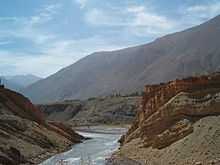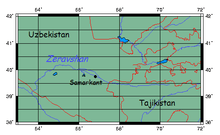Zeravshan River


Zeravshan River (also Zarafshan or Zarafshon, Tajik: Дарёи Зарафшон, Uzbek: Zarafshon, from the Persian word Persian: زرافشان zar-afshān, meaning "the sprayer of gold") is a river in Central Asia. Its name, "sprayer of gold" in Persian, refers to the presence of gold-bearing sands in the upper reaches of the river. To the ancient Greeks it was known as the 'Polytimetus'. It was also formerly known as Sughd River.
It rises at 39°30′N 70°35′E / 39.500°N 70.583°E on the fringes of the Pamirs in Tajikistan, flowing due west for some 300 kilometres (190 mi), passing Penjikent before entering Uzbekistan at 39°32′N 67°27′E / 39.533°N 67.450°E, where it turns west-to-north-west, flowing past the legendary city of Samarkand, which is entirely dependent on the oasis thus created, until it bends left again to the west north of Navoiy and further to the south-west, passing Bukhara before it is lost in the desert beyond the city of Qorako‘l (Karakul), not quite reaching the Amu Darya, of which it was formerly a tributary.
Tajikistan aims to construct a 100 MW hydro-electric power station on Zeravshan River and has signed in September 2012 a MoU with the Indian BHEL for the construction of the plant.[2]
See also
- Zarafshan, a city in Uzbekistan's Navoiy Province, called "the gold capital of Uzbekistan".
- Zarafshan (disambiguation)
Notes
- ↑ Samarkand, Uzbekistan
- ↑ "BHEL Signs MoU with Tajikistan for 100-MW Hydro-Electric Power Project". The Gazette of Central Asia (Satrapia). 5 September 2012. Retrieved 5 September 2012.
References
 Rines, George Edwin, ed. (1920). "Zerafshan". Encyclopedia Americana.
Rines, George Edwin, ed. (1920). "Zerafshan". Encyclopedia Americana.
Further reading
| Wikimedia Commons has media related to Zeravshan River. |
- В.В. Бартольд "К Истории Орошения в Туркестане" (Collected Works, Vol.3) (Москва) 1965
- V.V. Barthold "Turkestan Down to the Mongol Invasion" (London) 1968
- Robert Lewis "Early Irrigation in West Turkestan" Annals of the Association of American Geographers Vol.56 №.3 (Sept. 1966) pp467–491
- Edgar Knobloch "Beyond the Oxus" (London) 1972
